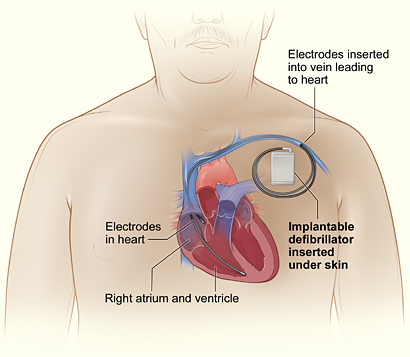How Can Death Due to Sudden Cardiac Arrest Be
Prevented?
Ways to prevent death due to sudden cardiac arrest
(SCA) differ depending on whether a person has already had SCA; has never had
SCA but is at high risk; or has never had SCA and has no known risk factors for
it.
For People Who Have Survived Sudden Cardiac
Arrest
People who have already had SCA are at high risk of
having it again. For these people, research shows that an implantable
cardioverter defibrillator (ICD) reduces the chances of dying from a second
SCA. An ICD is surgically implanted under the skin. It continually monitors the
heartbeat and delivers a shock to the heart when it detects a dangerous rhythm.
The shocks can be painful, like a kick in the chest. Medicines can be given to
try to reduce how often the person experiences the irregular heartbeats that
trigger the device to deliver a shock.

The illustration shows the location
of an implantable cardioverter defibrillator in the upper chest. The electrodes
are inserted into the heart through a vein.
An ICD is not the same as a pacemaker. Doctors
mainly use pacemakers to treat hearts that beat too slowly. However, some ICDs
also can function as pacemakers.
For People at Increased Risk of a First Sudden
Cardiac Arrest
People with severe
coronary
artery disease (CAD) are at increased risk for SCA. This is especially true
if they have recently had a
heart
attack. For these people, a type of medicine called a beta blocker can help
reduce the chances of dying from SCA.
For People With No Known Risk Factors for Sudden
Cardiac Arrest
The underlying cause of most SCAs seems to be CAD.
CAD also is a major risk factor for
angina
and heart attack, and it contributes to other heart problems. Heart-healthy
lifestyle choices can help you reduce your chances of CAD, SCA, and other heart
problems. These lifestyle choices include:
- Eating a diet low in cholesterol and saturated
fats and high in omega-3 fatty acids (see the National Heart, Lung, and Blood
Institute's
Aim for a Healthy Weight Web site).
- Participating in physical activity
- Not smoking
- Maintaining a healthy weight
Treatments for
high
blood pressure,
diabetes, and
high
blood cholesterol also help lower the risk for SCA.
|

